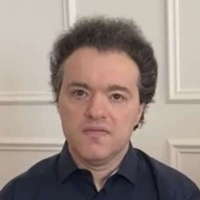 LISTENING TO TCHAIKOVSKY: Béla Hartmann uses his knowledge of Eastern Europe to argue against the banning of all Russian culture following Vladimir Putin's invasion of Ukraine.
LISTENING TO TCHAIKOVSKY: Béla Hartmann uses his knowledge of Eastern Europe to argue against the banning of all Russian culture following Vladimir Putin's invasion of Ukraine.

Three Premieres in Rome
GIUSEPPE PENNISI listens to music by
Ivan Fidele, Taneyev, Scriabin and Stravinsky
Two determinants induced me to go to a concert of the National Santa Cecilia Academy's symphonic series on 13 April 2019 - the third of three performances: a young, rising star of the Russian conducting world, and the presentation of three premieres, along with a well-known repertory item.
The conductor was Stanislav Kochanovsky, who had highly impressed me at the 2016 Florence May Music Festival (Maggio Musicale Fiorentino) where I had heard a production of Tchaikovsky's Iolanta. The overall production was not memorable, but I wrote that 'the young Russian conductor Stanislav Kochanovsky was a real surprise for the skills he demonstrated in dealing with the complex score and in providing the atmosphere, colors and tints it requires.' - 'A Precursor to Decadentism', Music & Vision, 3 May 2016.

Stanislav Kochanovsky conducting in Rome. Photo © 2019 Musacchio, Ianniello & Pasqualini
The three premieres were: the first performance of Ivan Fedele's Lexikon III - a commission from the National Santa Cecilia Academy; the first Rome performance of Sergei Taneyev's Giovanni di Damasco; and the first performance in the National Santa Cecilia Academy's symphonic concert service of Alexander Scriabin's Concerto for piano and orchestra in F sharp minor Op 20. The repertory piece was the 1919 version of Igor Stravinsky's well-known Firebird Suite. The program is part of the strategy to acquaint audiences gradually with new and unknown music. The vast auditorium was nearly full - a good sign that this strategy is having a positive impact.
The highly regarded and versatile Italian composer Ivan Fedele (born 1953) writes mainly symphonic and chamber music, but I remember vividly his one act opera Antigone which was awarded the Abbiati Price by the Italian Association of Music Critics in 2006. For several years, he has been responsible for the international contemporary music festival in Venice - the Biennale. Lexikon III is part of a symphonic cycle on various musical themes. Eventually, it will have four sections, giving a total duration of about forty minutes. The sections are to be played two at a time.
At this concert, two sections had their first performances: 'Multiplicity' and 'Consistency'. The former deals with the multiple relations musical ideas have between themselves, both over time and simultaneously. The latter is based on only one musical concept, presented in a variety of ways: the dominant acoustic principle is that of attack-resonance. The composition requires a large orchestra and has a duration of some fifteen minutes. There is no break between 'Multiplicity' and 'Consistency', but the listener senses the difference very strongly. 'Multiplicity' is quite rhythmic: violins, clarinets, piano and vibraphone seem to almost dominate the orchestra. In 'Consistency', the attack-resonance principle is expanded, compressed and cast in a variety of registers; the double basses have a key role, especially in the final moment. These fifteen minutes of complex contemporary music required, no doubt, a lot of rehearsal. Kochanovsky and the orchestra acquitted themselves very well of such a difficult task. They were rewarded by warm applause from the audience.

Members of the Orchestra dell'Accademia Nazionale di Santa Cecilia. Photo © 2019 Musacchio, Ianniello & Pasqualini
From the universe of contemporary music, the program moved to three Russsian cameos of the late nineteenth and early twentieth century. Giovanni di Damasco by Sergei Taneyev, first performed in 1884 in Moscow, is a choral tone poem of twenty-five minutes. It is based on poetry by Alexei Tolstoy, a second cousin of the better known Lev Tolstoy. The chorus (directed by Ciro Visco) is the protagonist of a solemn anthem about death. The orchestra does not merely support the voices, but provides colors and tints. The audience was pleased.
Although rarely performed, Scriabin's Concerto for piano and orchestra in F sharp minor, Op 20 (Odessa, 1897) is a very elegant and graceful score where the dialogue between the soloist and the huge orchestra contains spectacular virtuoso sections with a variety of melodic ideas. The pianist's part is patterned on Chopin's models. The pianist was the world famous Benedetto Lupo. The audience was enthralled, and Lupo also had to offer an encore.

Benedetto Lupo performing in Rome. Photo © 2019 Musacchio, Ianniello & Pasqualini
The Firebird Suite ('L'oiseau de feu', Paris, 1909) is a repertory piece to please long time subscribers, less acquainted with contemporary music than with late nineteenth century Russian scores. I could feel that the orchestra knew this very well, and that Kochanovsky didn't need much rehearsal with them. The audience was enthusiastic.
Copyright © 16 April 2019
Giuseppe Pennisi,
Rome, Italy




